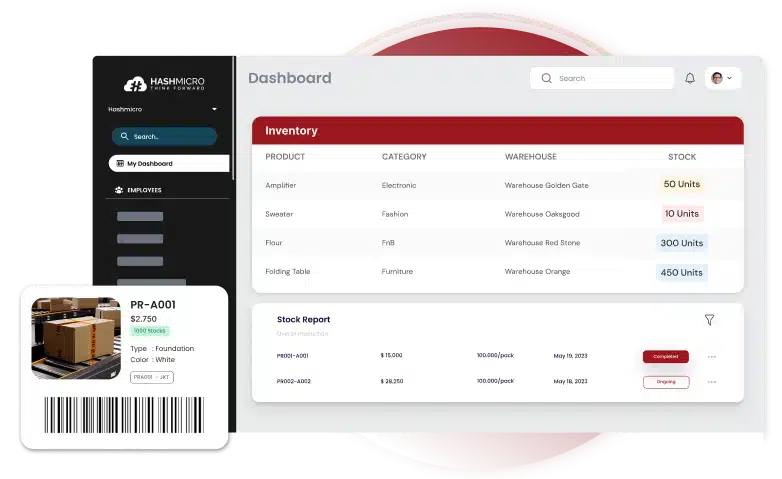Dynamic slotting plays a key role in warehouse management, but many businesses still stick to old-fashioned static systems. Without dynamic slotting, companies face slow picking times, inefficient use of space, and higher costs.
When warehouses can’t adapt to real-time demand, they end up with misplaced stock, wasted labor, and missed chances to streamline their operations. Do you know studies estimate that fewer than 15% of SKUs are currently stored in optimal locations?
Companies that switch to dynamic slotting enjoy real-time stock updates, faster order fulfillment, and better use of warehouse space. In this article, we’ll explore dynamic slotting, its benefits, and why it’s a must for efficient warehouse management.
Key Takeaways
|
What is Dynamic Slotting?
Dynamic slotting is a sophisticated warehouse management technique that optimizes the location of products within a warehouse based on various factors such as SKU velocity (the rate at which items sell), seasonality, product turnover, and market demand.
This approach stores high-demand products or those with high turnover closer to the packing or shipping area to minimize the time spent picking these items. Meanwhile, slower-moving or less critical items are stored farther back in the warehouse.
The system uses real-time data to reassess the most efficient storage locations, factoring in market trends, profitability, and space constraints.
This strategy is especially beneficial in environments with limited warehouse space or fluctuating demand, as it maximizes storage capacity and picking efficiency. Dynamic slotting ensures that the warehouse operates at peak efficiency.
Benefits of Dynamic Slotting

Dynamic slotting helps warehouses stay efficient by adjusting product placements based on real-time data. By tracking key factors like demand and turnover, it ensures that items are stored in the best possible spots.
Below are some of the most significant benefits of dynamic slotting:
1. Maximizing available space
Traditional slotting systems often waste both space and time. In fact, research shows that order picking, including searching and handling items, takes up roughly 55% of warehouse operating costs, with traveling alone accounting for the largest portion of order preparation time.
Dynamic slotting addresses this issue by minimizing travel time and placing high-demand products in more accessible areas, helping businesses make better use of their space and resources.
2. Adapting to seasonal and sudden demand fluctuations
Warehouses often struggle to keep up with seasonal spikes or unpredictable demand shifts. Dynamic slotting isn’t just about faster picking—it’s about making sure the right items are in the right place when they’re needed.
This agility means less downtime for reorganizing stock and better preparedness for high-velocity periods like holidays or sales events, where demand for certain products can skyrocket overnight.
3. Managing SKU’s rapid increase effectively
Warehouses often manage an expanding range of SKUs, which leads to confusion about how and where to store everything. Dynamic slotting keeps fast-moving products right where you need them—front and center.
With real-time data driving the process, especially with tools like warehouse management system in Singapore, there’s no need for constant manual adjustments. Just let the system do its thing and the team can focus on other important matters.
4. Minimizing re-slotting downtime
One of the biggest time-wasters in a warehouse is re-slotting: moving items manually to new locations as demands change. Gone are the days of laboriously rearranging inventory. Dynamic slotting automates the process, seamlessly shifting items as needed so your team can focus on getting orders out the door rather than shuffling shelves.
5. Real-time inventory visibility and forecasting
With dynamic slotting, it’s not just about where items are stored. Rather, it uses data to predict and respond to future needs. By syncing with inventory management systems, dynamic slotting does more than just organize; it helps you anticipate issues like stockouts or overstocking before they become problems. It’s about staying ahead, not just reacting.
6. Optimizing workforce efficiency
In an era of labor shortages, warehouses can’t afford inefficiency. Pickers benefit from dynamic slotting, too, with tasks assigned strategically to minimize walking and effort. This means quicker picks, less fatigue, and a smooth workflow even during labor shortages.
How Does Dynamic Slotting Work?
Dynamic slotting thrives on real-time data and precise algorithms, allowing warehouses to continually adjust and optimize their slots based on immediate needs, powered by machine learning and AI. Some key practices include:
- Assessing SKU velocity to ensure that fast-selling items are front-and-center and easily accessible for quick picking. Slower-moving products can be pushed further back, freeing up space for higher-demand items and improving overall efficiency.
- Adapting slotting strategies to match seasonal trends and sales cycles. When winter hits, for example, cold-weather gear gets moved up for easier access, only to shift back as warmer seasons approach. Similarly, new product releases can be slotted for prime picking locations to meet the anticipated rush.
- Regularly reviewing and tweaking slotting approaches ensures the system stays nimble. By staying proactive, you can respond to viral product demand or sudden shifts in buying trends, keeping popular items within quick reach of the packing area.
- Gathering insights from warehouse staff also plays a huge role. Those on the floor know firsthand what works and what doesn’t, providing invaluable feedback to refine and improve slotting strategies. For instance, pickers might flag that similar items cause confusion, prompting adjustments to reduce errors.
Dynamic vs. Static Slotting

It’s helpful to compare dynamic slotting to static slotting to grasp dynamic slotting. In static slotting, products are assigned fixed spots in the warehouse, and those spots remain unchanged, no matter how demand or sales trends shift.
This system works well for businesses with a small product range and consistently high turnover.
In contrast, dynamic slotting involves regularly shifting product locations based on factors like turnover rates. Here’s a more thorough explanation of the key differences between static slotting and dynamic slotting:
- Adaptability: Dynamic slotting constantly adjusts product locations based on real-time data, ensuring quick adaptation to shifting demand. Static slotting lacks this flexibility, as it requires manual effort to update storage spots, making it less responsive to changes.
- Space utilization: Dynamic slotting optimizes warehouse space by placing items strategically according to demand levels. In contrast, static slotting may leave areas underutilized if product demand varies, resulting in wasted space.
- Scalability: Dynamic slotting easily scales to handle inventory growth or seasonal peaks. Static slotting, however, may need considerable reorganization or even warehouse expansion to cope with such changes.
For example, in logistics hubs, dynamic slotting is applied by refilling empty bins with various items.
At fulfillment centers in Singapore, dynamic slotting is crucial in handling their massive product variety. Empty slots are refilled with different items based on current demand. This system allows companies to meet fluctuating customer needs quickly without compromising on storage space.
Dynamic slotting will be done easier when managed with a comprehensive warehouse management system. Moreover, a robust WMS can also integrate with different systems, like accounting, inventory, and sales for a more holistic approach to your workflow.
Curious about how much this technology will cost you? You can click on the pricing calculator below to get a personalized plan for your specific needs.
Best Practices for Dynamic Slotting
Now that you understand the benefits of dynamic slotting, how can you apply it effectively in your warehouse? Here are some essential best practices to help you implement it smoothly and maximize efficiency:
1. Maintain accurate and real-time data
Dynamic slotting lives or dies by the quality of your data. Regularly check and update key metrics like SKU velocity, seasonality, and turnover rates to ensure your system has the most accurate information to guide smart storage decisions.
2. Create clear picking zones
Simplify the picking process by designating clear zones for high, medium, and low-demand products. With well-defined areas, your team will waste no time hunting for items—everything is exactly where it needs to be for fast, efficient fulfillment.
3. Regularly monitor and adjust
Dynamic slotting is an ongoing process. Continuously assess how well your current strategy works and adjust when necessary to keep up with changing demand and trends. Flexibility is key to maintaining an efficient warehouse.
4. Utilize a strong WMS
Your warehouse management software (WMS) should be the engine behind dynamic slotting. It can quickly adjust to shifting demands by integrating real-time inventory and order data, automatically creating slots for trending or high-priority items. Make sure it’s equipped to handle dynamic algorithms and adapt to ever-changing needs.
Elevate Your Warehousing Approach with HashMicro’s WMS

Dynamic slotting demands careful coordination, and achieving this level of precision is only possible with the right tools. Warehouse management software that offers real-time, accurate data, like HashMicro’s Warehouse Management System Singapore, takes the guesswork out of managing inventory.
This robust software allows warehouses to create or adjust slots based on the latest demand, ensuring efficiency at every step.
HashMicro’s WMS serves as the nerve center for your warehouse operations. With real-time visibility into stock and bin levels, you’re always in control. It also seamlessly syncs with your e-commerce platform or order management system to access vital details such as fulfillment dates and sales trends.
This software offers advanced features to help Singaporean companies transform their warehousing processes:
- Real-time inventory tracking: Stay on top of your stock with instant updates, so you’re never left guessing when it’s time to adjust or reorder.
- Automated slotting and reordering: Let the system handle the heavy lifting—automatically moving products where needed and restocking without the hassle.
- Barcode and RFID integration: Speed up the picking process with quick scans, ensuring accuracy even when stock locations shift.
- Multi-warehouse management: Effortlessly manage inventory across different locations with a single system, making sure everything runs smoothly, no matter where your stock is.
- Customizable reports and analytics: Get tailored insights to help you fine-tune your warehouse strategy and use data to stay ahead of demand.
- Labor management: Keep your team working efficiently, with the system helping you allocate tasks and track performance as your warehouse adapts.
Conclusion
Dynamic slotting keeps your warehouse efficient by adjusting product locations based on real-time demand. It ensures that fast-moving items are easily accessible, while slow sellers are stored further back. This approach is perfect for warehouses dealing with tight spaces or unpredictable demand.
For Singaporean businesses, HashMicro’s Warehouse Management System is a game-changer. It offers real-time inventory tracking, automated slotting, and seamless integration with your order systems. With HashMicro, you can ditch the manual work and let smart algorithms handle the heavy lifting, improving productivity without the headaches.
By choosing HashMicro, you’re equipping your business with the tools to stay ahead in logistics. Whether you’re managing multiple warehouses or need detailed analytics, HashMicro’s WMS adapts to your needs for simplified workflows and better warehousing and stock management.
What are you waiting for? Explore the benefits HashMicro can give you by trying out our free demo!
Warning: Undefined array key "med" in /home/hashmicr/public_html/blog/wp-content/plugins/insert-headers-and-footers/includes/class-wpcode-snippet-execute.php(419) : eval()'d code on line 281

FAQ About Dynamic Slotting
-
What industries benefit the most from dynamic slotting?
Industries like e-commerce, retail, food and beverage, and pharmaceuticals benefit greatly from dynamic slotting due to their fluctuating demand and need for fast turnover.
-
Can dynamic slotting be used in multi-warehouse operations?
Yes, dynamic slotting works well for managing inventory across multiple warehouses by optimizing placements based on real-time data at each location.
-
How does dynamic slotting handle unexpected demand spikes?
Dynamic slotting automatically reallocates high-demand items to accessible areas, allowing warehouses to quickly meet sudden demand without disruptions.
-
What are some challenges of implementing dynamic slotting?
Challenges include the need for accurate real-time data, a strong WMS, and retraining staff to adapt to frequent changes in product locations.














